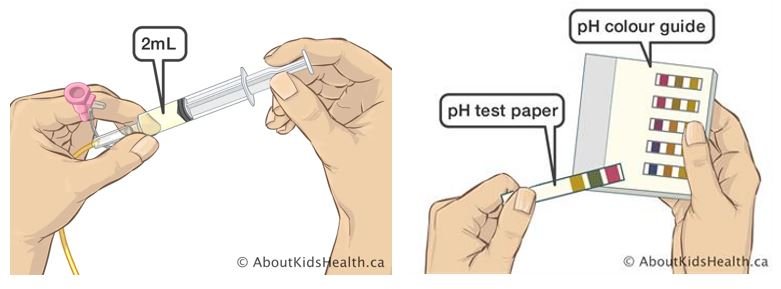HINT: What to do when you cannot obtain aspirate from a nasogastric (NG) tube to confirm placement?
Connected Care Quick Hits are up to date and evidence based recommendations for the care of children with medical complexity & technology dependence, from hospital to home.
HINT: What to do when you cannot obtain aspirate from a nasogastric (NG) tube to confirm placement?
SITUATION:
This QuickHit was informed by consults from family caregivers who require support with troubleshooting to obtain gastric aspirate from their child’s NG tube for placement verification at home.
BACKGROUND:
Children with medical complexity may rely on NG tubes to support nutrition, hydration and/or medication administration. With the increasing use of NG tubes in home and community settings, there are important assessments and considerations to ensure safety of children and to prevent complications such as aspiration, tube migration and dislodgement.
ASSESSMENT:
Placement of the NG tube is confirmed by measuring the pH of gastric aspirate using pH test strips (as shown in the images below). NG tube placement is checked:
Before using the NG tube for feeds, fluids or medications
When a new NG tube is inserted
When you are concerned that the NG tube may have come out or moved
If the child is choking, vomiting, coughing or having trouble breathing
Placement of the NG tube can be confirmed via pH testing of the gastric aspirate by performing the following steps:
Attach an empty syringe to the adapter on the NG tube and gently flush with 1 to 2 mL air to clear the tube
Pull back on the plunger to withdraw about 2 mL of stomach contents
Wet pH testing paper with the stomach contents and compare the colour of the strip with the label on the container
For majority of children, pH of the gastric aspirate will be less than 5. Some children on acid-suppressing medication, those recently fed, or being continuously fed may have a gastric pH greater than 6*.
RECOMMENDATION:
Connected Care recommends the following troubleshooting techniques if there is difficulty obtaining gastric aspirate from an NG tube to confirm placement:
Use a larger syringe (e.g., 6 mL or 12 mL) and draw back gently to prevent collapsing the tube.
Instill a small amount of air (1 to 2 mL) through the NG tube into the stomach. This can move the position of the tube away from the stomach tissue to an area where there is gastric contents.
Change the child’s position by having them lie on their right or left side for a few minutes. This may help gastric contents pool in a location that can be accessed by the NG tube.
Offer the child food and/or drink if they can safely feed by mouth. The gastric contents may look like the food and/or drink that was fed by mouth.
If the previous troubleshooting strategies are not successful, remove and re-insert the NG tube (if indicated).
Consult Connected Care Live for real-time support with NG tube troubleshooting and review the following AboutKidsHealth resource that outlines troubleshooting strategies. Partner with family caregivers to understand the timeline provided by their clinical team for the transition to the Astral ventilator. This information will help planning education for home and community care providers.















